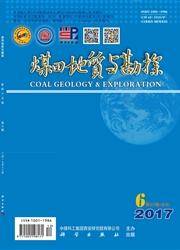

 中文摘要:
中文摘要:
西南地区上二叠统赋存有丰富的煤炭资源,含煤地层自下而上分别是峨眉山玄武岩组、龙潭组(宣威组中、下段或吴家坪组)和长兴组(宣威组上段或汪家寨组)。本文对该区晚二叠世含煤岩系层序地层、岩相古地理及聚煤作用进行研究,以区域不整合面、沉积相转换面以及下切谷砂体底部冲刷面等为层序界面,结合石灰岩标志层向古陆方向延伸距离而显示的旋回性特征,将区内含煤岩系划分为3个三级层序和相应的低位、海侵及高位体系域。层序1形成于晚二叠世吴家坪阶早期,主要分布在川南隆起的南北两侧,包括川东北及滇东、黔西地区;层序2形成于吴家坪阶中期,层序3形成于吴家坪阶晚期及长兴阶,层序2和层序3在西南全区均发育。三个层序的发育特征反映出海侵自东向西脉动推进、东深西浅的古地理格局,当时物源区主要为西侧的康滇古陆,沉积相单元有从西到东依次为陆相冲积平原—过渡相潮坪及三角洲—海相碳酸盐台地的沉积相展布规律。成煤环境主要为河流岸后沼泽、三角洲平原分流间湾沼泽、海湾(泻湖)—潮坪沼泽等,以三角洲体系成煤作用最强。总体上随着海水自东向西不断侵进,有利的成煤环境亦随着海平面的上升而不断向西迁移,聚煤中心亦有逐渐向西迁移的规律。
 英文摘要:
英文摘要:
The Upper Permian in southwestern China was developed with abundant coal resources, and is divided into three formations including Emeishan Basalt Formation, Longtan Formation (lower and middle memberss of Xuanwei Formation or Wujiaping Formation) and Changxing Formation (upper member of Xuanwei Formation or Wangjiazhai Formation) from bottom to top. The sequence stratigraphy, paleogeography, and coal accumulation of the Late Permian in this region have been studied based on outcrop and borehole sections. According to regional unconformities, sedimentary facies reversal surface, base of incised valley fill sandstones, and distribution of marine limestone beds which reflects variation of the transgressions, we have subdivided the Later Permian into 3 third-order sequences and related lowstand, transgressive, highstand systems tracts. Sequence 1 corresponds to the intervals of early Wujiaping stage, and is distributed mainly in the northeastern Sichuan, eastern Yunnan and western and eastern Guizhou. Sequence 2 corresponds to the middle Wujiaping stage, and Sequence 3 corresponds to late Wujiaping stage though Changxing stage. Both Sequence 2 and Sequence 3 are all distributed in the whole region of southwestern China. The vertical and lateral variation of facies in three sequences reveals a overall transgression pattern of palaeogeography. From bottom (Sequence 1) to top (Sequence 3) and from west to east, there was a variation in facies units from fluvial plain, through tidal-delta combination, to shallow marine. In these three sequences,depositional environments are all deeper in the east, and shallower in the west, with the transgressive pulse of advancing from east to west. The coal-forming environments are swamps developed from fluvial overbank, interdistibutary bay, lagoon-tidal flat environments, while the favorable coal-forming environment is the interdistributary bay of the delta plain. In the three sequences, with the overall westward transgression, beneficial coal-forming environments a
 同期刊论文项目
同期刊论文项目
 同项目期刊论文
同项目期刊论文
 Sequence stratigraphy and paleogeography of the late Triassic coal-measures in South China: Implicat
Sequence stratigraphy and paleogeography of the late Triassic coal-measures in South China: Implicat CYCAD WOOD FROM THE LOPINGIAN (LATE PERMIAN) OF SOUTHERN CHINA: SHUICHENGOXYLON TIANII GEN. ET SP. N
CYCAD WOOD FROM THE LOPINGIAN (LATE PERMIAN) OF SOUTHERN CHINA: SHUICHENGOXYLON TIANII GEN. ET SP. N Sedimentology and sequence stratigraphy of the Lopingian (Late Permian) coal measures in southwester
Sedimentology and sequence stratigraphy of the Lopingian (Late Permian) coal measures in southwester Linked sequence stratigraphy and tectonics in the Sichuan continental foreland basin, Upper Triassic
Linked sequence stratigraphy and tectonics in the Sichuan continental foreland basin, Upper Triassic Sequence stratigraphy and paleogeography of the Middle Jurassic coal measures in the Yuqia coalfield
Sequence stratigraphy and paleogeography of the Middle Jurassic coal measures in the Yuqia coalfield Constraints on carbon accumulation rate and net primary production in the Lopingian (Late Permian) t
Constraints on carbon accumulation rate and net primary production in the Lopingian (Late Permian) t The anatomically preserved stem Zhongmingella gen. nov from the Upper Permian of China: evaluating t
The anatomically preserved stem Zhongmingella gen. nov from the Upper Permian of China: evaluating t A unique trunk of Psaroniaceae (Marattiales)-Psaronius xuii sp nov., and subdivision of the genus Ps
A unique trunk of Psaroniaceae (Marattiales)-Psaronius xuii sp nov., and subdivision of the genus Ps Xuanweioxylon scalariforme gen. et sp nov.: Novel Permian coniferophyte stems with scalariform borde
Xuanweioxylon scalariforme gen. et sp nov.: Novel Permian coniferophyte stems with scalariform borde 期刊信息
期刊信息
